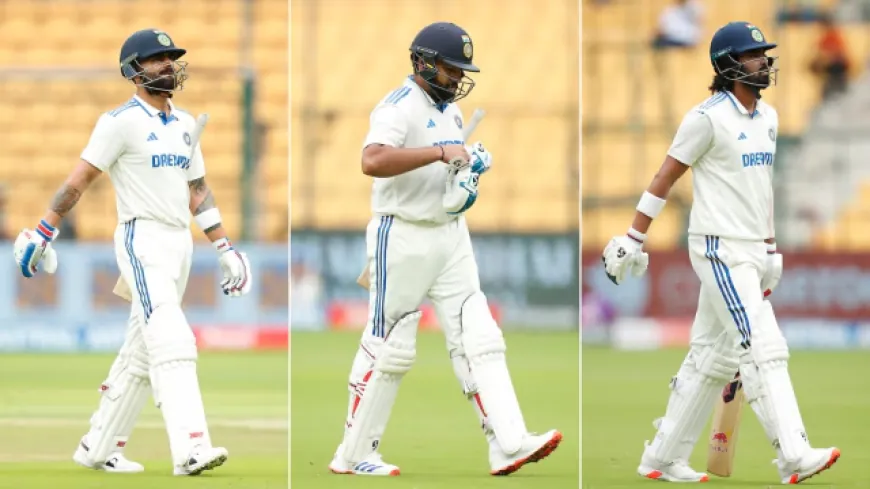India’s Lowest Test Scores at Home: A Historical Perspective
Historical Context Looking back at India's cricket history, low scores have often been a part of the game, serving as a reminder of the challenges of Test cricket. It’s not uncommon for even the best teams to experience batting failures, but the key lies in how quickly they can bounce back. India's remarkable comeback in the 2020-21 Border-Gavaskar Trophy is a testament to their ability to overcome adversity.

India’s preparations for the first Test against New Zealand at the M Chinnaswamy Stadium in Bengaluru on October 17, 2024, faced a turbulent start, highlighted by a swift collapse of the top order. This unfortunate performance not only added to the team's woes but also brought to the forefront the discussion around India's lowest Test scores at home.
The recent match has drawn comparisons to previous humiliations, particularly recalling India’s lowest total ever, which was recorded during their 2020-21 tour to Australia. In a shocking display at the Adelaide Oval, the Indian team was bowled out for just 36 runs, marking only the second time in their Test history that they had finished with a score below 50. However, the team exhibited resilience and went on to win the series 2-1, including a remarkable victory in Brisbane.
A Look Back at India’s Lowest Scores at Home
Historically, India has had a few dismal innings at home that have left a mark on their Test cricket legacy. Below is a list of the lowest Test scores recorded by India on home soil:
-
46 all out vs. New Zealand, Bengaluru (2024): This match not only stands as India's lowest total at home but also highlights the fragility of the batting lineup. The team was dismissed in just 31.2 overs, with Matt Henry claiming five wickets for 15 runs.
-
75 all out vs. West Indies, Delhi (1987): Before the recent record, India’s previous lowest home score was against the West Indies in 1987. The match became a stark reminder of how quickly a batting lineup can falter.
-
76 all out vs. South Africa, Ahmedabad (2008): This innings showcased the challenges faced by Indian batsmen against quality seam bowling, as they struggled to negotiate the South African attack.
-
83 all out vs. England, Chennai (1977): The Indian team faced a similar fate against England, where they failed to capitalize on their home advantage.
-
83 all out vs. New Zealand, Mohali (1999): A dismal performance that added to New Zealand's growing reputation as a challenging opponent for India.
-
88 all out vs. New Zealand, Brabourne (1965): This innings further illustrated India's historical battles against New Zealand in Test matches.
-
89 all out vs. New Zealand, Hyderabad (1969): Another low point against New Zealand, reflecting the recurring difficulties India has faced against this particular opponent.
The Impact of Poor Scores
These low scores have not only reflected poorly on the Indian team at various times but have also served as a wake-up call for players and management alike. The psychological impact of such performances can linger, affecting player confidence and team morale. In the aftermath of their recent innings, discussions have surfaced regarding the need for a more robust batting strategy, particularly in home conditions.
The Recent Collapse Against New Zealand
In the match against New Zealand, the Indian team managed to record their lowest-ever score at home after losing a series of quick wickets. The top order faltered, and even key players were unable to make significant contributions. This performance has raised concerns among fans and analysts regarding the depth and resilience of the current batting lineup.
The bowling attack of New Zealand, led by Matt Henry and William O’Rourke, exploited the conditions expertly, putting immense pressure on the Indian batsmen. As the innings progressed, it became increasingly evident that India was struggling to adapt to the seam-friendly conditions, leading to a disheartening collapse.
Historical Context
Looking back at India's cricket history, low scores have often been a part of the game, serving as a reminder of the challenges of Test cricket. It’s not uncommon for even the best teams to experience batting failures, but the key lies in how quickly they can bounce back. India's remarkable comeback in the 2020-21 Border-Gavaskar Trophy is a testament to their ability to overcome adversity.
The Road Ahead
As India reflects on this latest performance, it will be crucial for the team management to address the issues that led to such a disappointing total. A focus on mental toughness, along with technical adjustments, could help in avoiding such disasters in future matches. The batting lineup may need to adopt a more adaptable approach, learning to tackle challenging conditions while remaining aggressive when opportunities arise.
The stark reminder of India's lowest Test scores at home, culminating in the recent collapse against New Zealand, has sparked necessary conversations about the future of Indian cricket. With a storied history of remarkable comebacks and strong performances, the hope remains that the team can rebound from this setback and return to its winning ways. As they move forward, addressing the weaknesses exposed in the recent match will be vital to regaining their status as a dominant force in international cricket.





















































